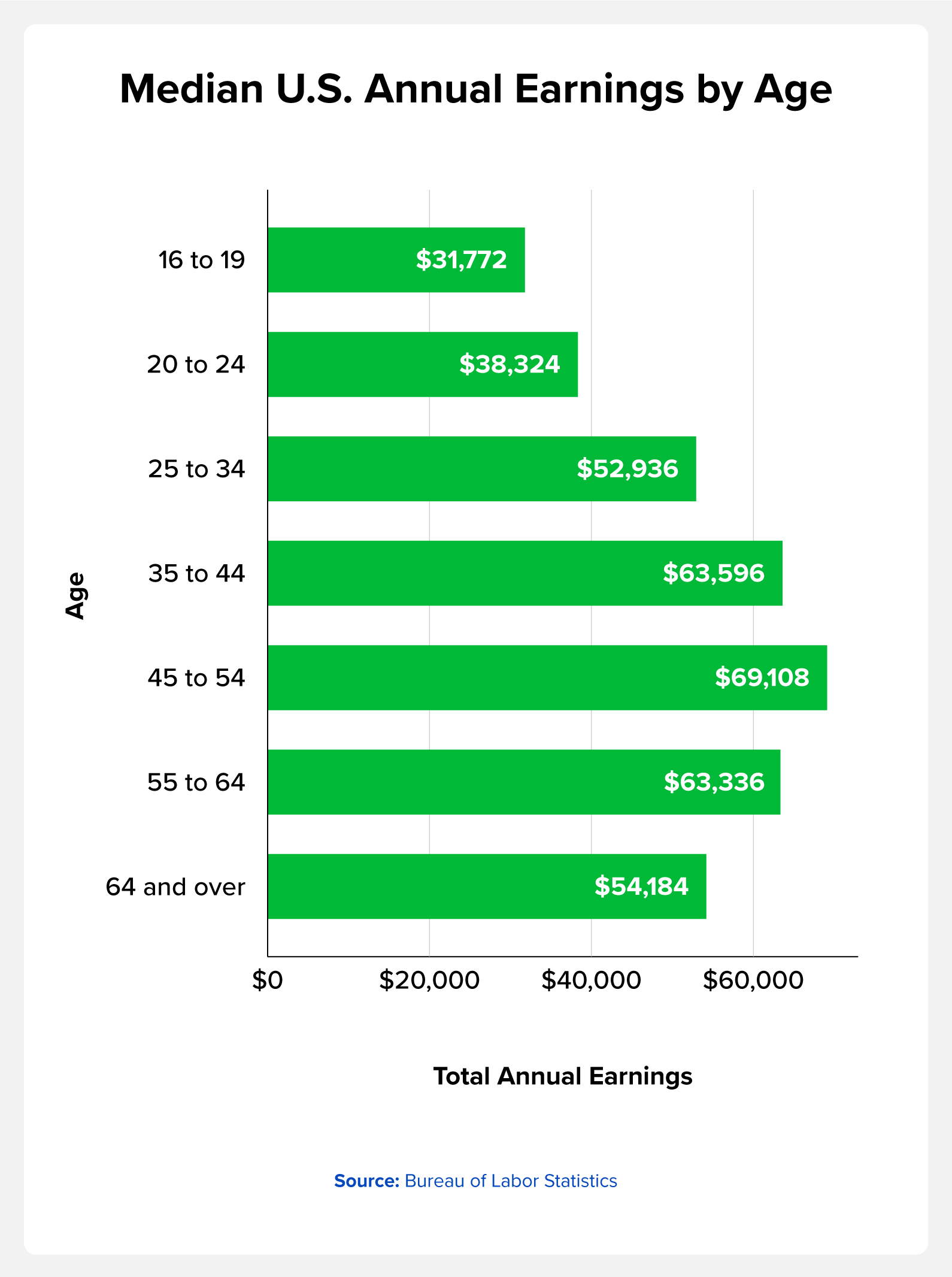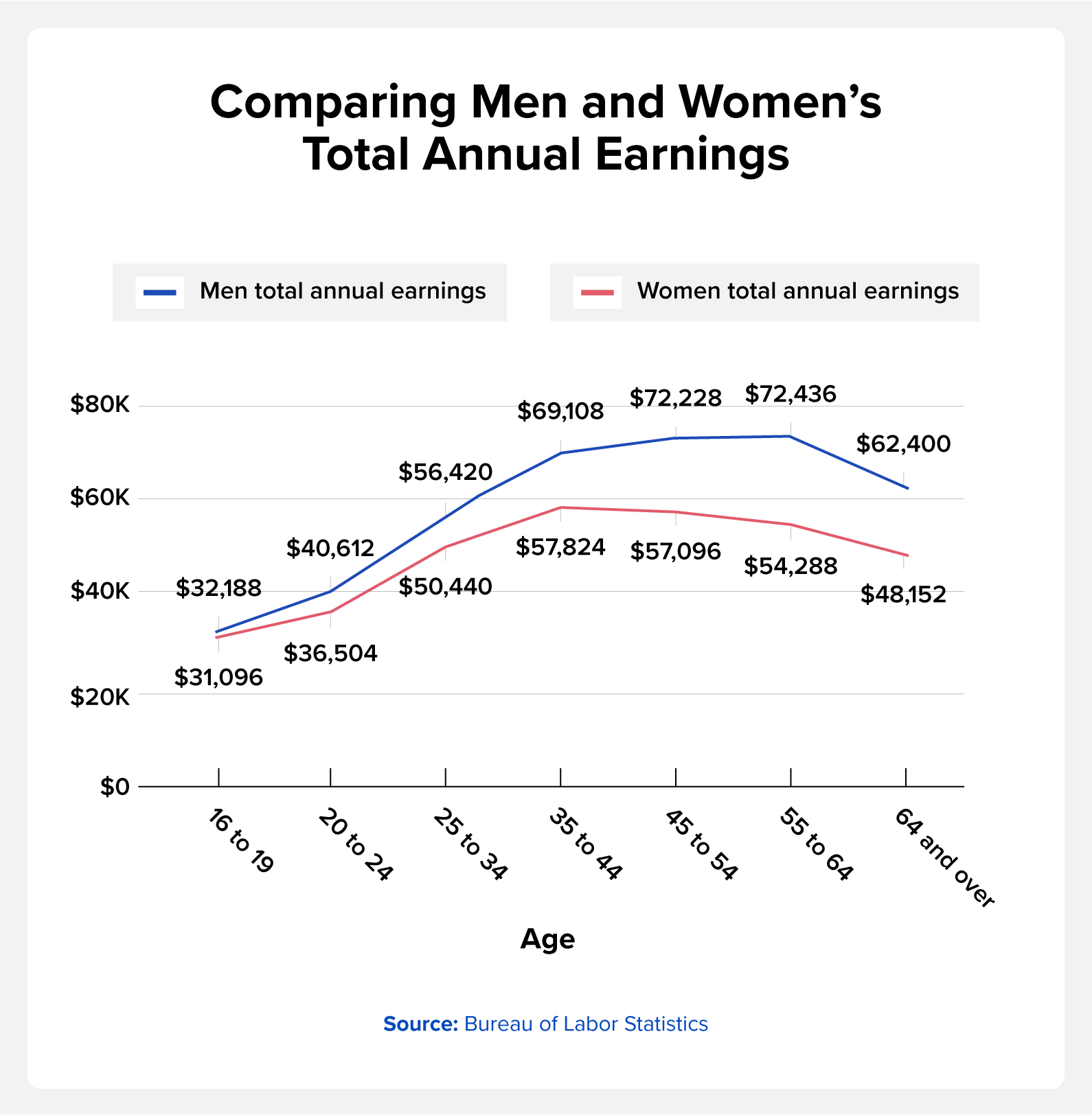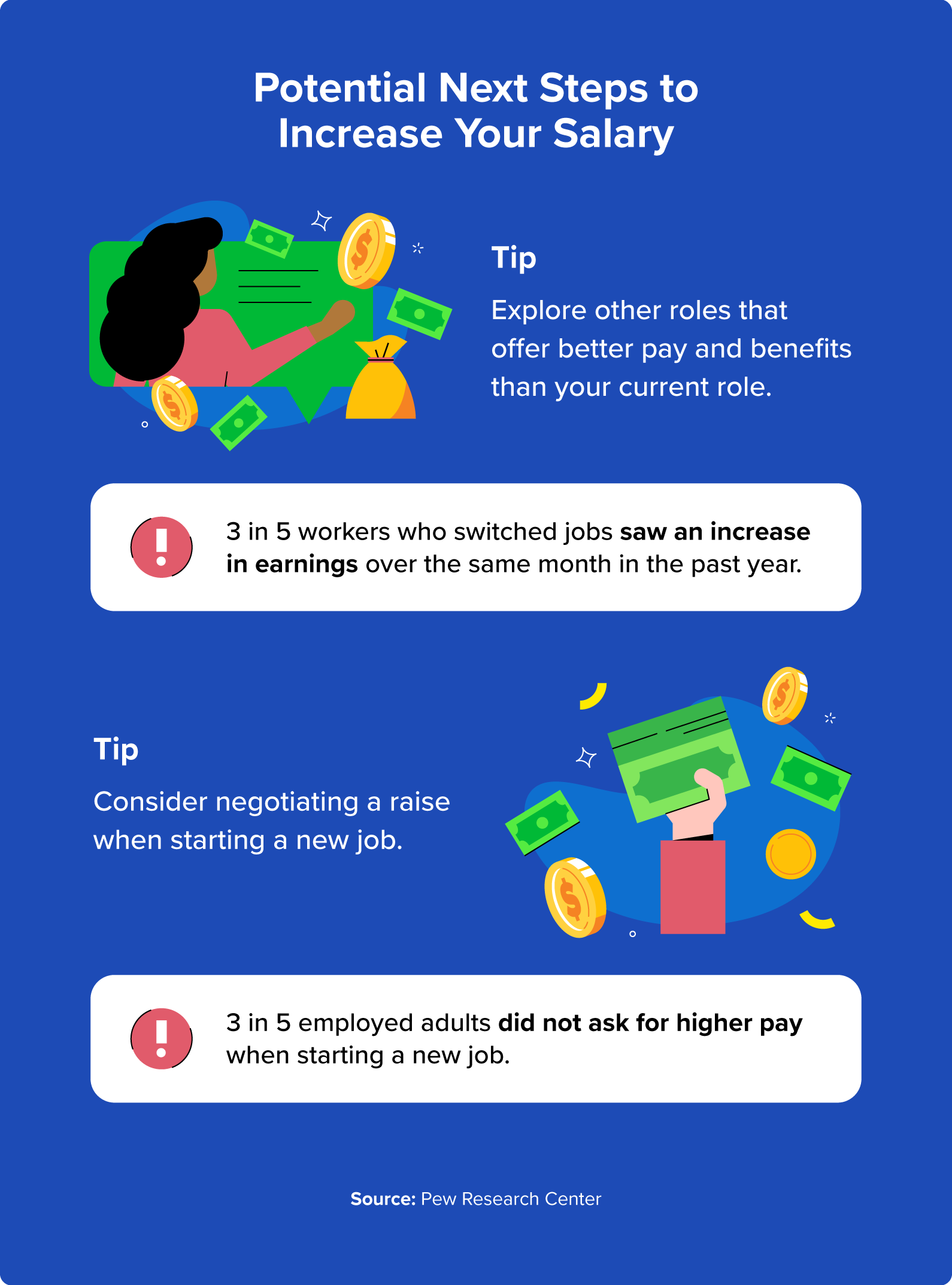![An Inside Look at Differences in Salary by Age [2023]](https://www.credit.com/blog/wp-content/uploads/2024/10/average-salary-by-age-hero.webp)
Many or all of the products featured here are from our partners who compensate us. This may influence which products we write about and where and how the product appears on a page. However, this does not influence our evaluations.
With the job landscape constantly fluctuating, it’s not easy to grasp how your salary compares to your peers. However, workers can miss out on information impacting their financial journey if they don’t dig into salary data.
For instance, knowing the breakdown of American salaries by age can help people understand how their salaries can potentially progress. This data can also help inform how a person manages their finances in the long-term and other major decisions (like negotiating a salary raise).
Below, we look at salary by age in the U.S. and other breakdowns to help you see where you stand.
Differences in Salary by Age for U.S. Workers
Earnings data from the Bureau of Labor Statistics (BLS) finds that workers generally make more as they get older.
- The median salary is $57,200 ($1,100 median usual weekly earnings) for full-time wage and salary workers 16 years of age and older.
- Wages peak for all workers when they reach 45 to 54 years old.
- Median earnings increase for workers in the 25 to 34-year-old age range and start to drop off in the 55 to 64-year-old range.
Note that BLS uses measures like median wages instead of only averages to get more information, especially for a large range of data. For example, median weekly earnings can paint a more accurate picture than an average because it can’t get skewed by extremely high or low wages.
We take a look at differences in salary by age below by listing median weekly earnings and total annual salary (calculated by multiplying weekly earnings by 52 weeks).
|
Age |
Median weekly earnings |
Total annual earnings |
|---|---|---|
|
16 to 19 |
$611 |
$31,772 |
|
20 to 24 |
$737 |
$38,324 |
|
25 to 34 |
$1,018 |
$52,936 |
|
35 to 44 |
$1,223 |
$63,596 |
|
45 to 54 |
$1,239 |
$64,428 |
|
55 to 64 |
$1,218 |
$63,336 |
|
64 and over |
$1,042 |
$54,184 |

Other factors, like education level and gender, also impact a worker’s salary. We’ll go over these breakdowns below.
Salary Differences by Gender and Age
BLS data shows us the income gap between men and women increases with age.
- Median weekly earnings are closest for men ($619) and women ($598) who are 16 to 19 years old.
- Men ($1,393) make 33% more than women ($1,044) in the 55 to 64 age range. This is also the largest wage gap between men and women.
Data from the Department of Labor also shows that the gender earnings ratio and wage gap impacts women differently across race and ethnicity. For example, Black women have a 7.3% wage gap compared to Black men, while Asian women have a 21.9% wage gap compared to Asian men.
There are many financial resources for women that provide guides and tips for managing finances. Legislators are also introducing fair pay legislation and local equal pay initiatives (like the California Equal Pay Pledge) to help close the gap.
The chart below shows that the gender wage gap starts immediately from the 16 to 19 range and gradually grows with each age gap.
|
Age |
Men median weekly earnings |
Women median weekly earnings |
Men total annual earnings |
Women total annual earnings |
|---|---|---|---|---|
|
16 to 19 |
$619 |
$598 |
$32,188 |
$31,096 |
|
20 to 24 |
$781 |
$702 |
$40,612 |
$36,504 |
|
25 to 34 |
$1,085 |
$970 |
$56,420 |
$50,440 |
|
35 to 44 |
$1,329 |
$1,112 |
$69,108 |
$57,824 |
|
45 to 54 |
$1,389 |
$1,098 |
$72,228 |
$57,096 |
|
55 to 64 |
$1,393 |
$1,044 |
$72,436 |
$54,288 |
|
64 and over |
$1,200 |
$926 |
$62,400 |
$48,152 |

Salary Differences by Education Level
Income by age can also vary based on education level. BLS data comparing earnings and education level shows us:
- Those earning a bachelor’s degree or higher make more than those with less education.
- Workers with a bachelor’s degree see a 63% increase in median weekly earnings ($1,621) than those with some college or an associate degree ($995)).
Earnings gradually trend up as workers increase their education level. Educational attainment data from the U.S. Census Bureau shows us that nearly 38% of Americans 25 and older earned a bachelor’s degree or higher in 2022. However, several factors can impact a person’s ability to access higher education, including affordability.
A study from the National Center for Education Statistics found that only 38% of students who thought their family could not afford to send them to college (“non-afforders”) were enrolled. Workers who want to advance their education can start familiarizing themselves with ways to fund education, like learning the differences between student loans and financial aid.
The chart below shows BLS data on how earnings differ between each education level.
|
Education level |
Median weekly earnings |
Total annual earnings |
|---|---|---|
|
Less than a high school diploma |
$682 |
$35,464 |
|
High school graduates (no college) |
$884 |
$45,968 |
|
Some college or associate degree |
$995 |
$51,740 |
|
Bachelor’s degree and higher |
$1,621 |
$84,292 |
Salary Differences by State
Location can influence your salary and the cost of living in your area. BLS wage and state data show that:
- Massachusetts, New York, and California are the states that offer the highest wages.
- West Virginia, Arkansas, and Mississippi are the states that offer the lowest wages.
- A worker in Massachusetts makes 89% more than a worker in Mississippi.
However, higher wages don’t necessarily mean your dollar will go far. Understanding other factors, like the cost of living, can help understand how much your salary can support your living expenses.
The Bureau of Economic Analysis (BEA)’s regional price parity (RPP) data can give more context to the cost of living in each state. RPP measures the differences in price levels for a specific year. RPP values are represented as a percentage of the national price level (the U.S. = 100%).
For example, California has the third-highest wages and the second-highest RPP (nearly 112%). This means that California’s prices are higher than the national price level. In comparison, Mississippi offers the lowest wages but also has the lowest RPP (nearly 87%).
|
State |
Average weekly wages |
Total annual wages |
|---|---|---|
|
Alabama |
$1,158 |
$60,216 |
|
Alaska |
$1,299 |
$67,548 |
|
Arizona |
$1,272 |
$66,144 |
|
Arkansas |
$1,065 |
$55,380 |
|
California |
$1,679 |
$87,308 |
|
Colorado |
$1,472 |
$76,544 |
|
Connecticut |
$1,593 |
$82,836 |
|
Delaware |
$1,346 |
$69,992 |
|
Florida |
$1,284 |
$66,768 |
|
Georgia |
$1,289 |
$67,028 |
|
Hawaii |
$1,227 |
$63,804 |
|
Idaho |
$1,114 |
$57,928 |
|
Illinois |
$1,432 |
$74,464 |
|
Indiana |
$1,131 |
$58,812 |
|
Iowa |
$1,153 |
$59,956 |
|
Kansas |
$1,125 |
$58,500 |
|
Kentucky |
$1,099 |
$57,148 |
|
Louisiana |
$1,134 |
$58,968 |
|
Maine |
$1,165 |
$60,580 |
|
Maryland |
$1,462 |
$76,024 |
|
Massachusetts |
$1,790 |
$93,080 |
|
Michigan |
$1,274 |
$66,248 |
|
Minnesota |
$1,357 |
$70,564 |
|
Mississippi |
$947 |
$49,244 |
|
Missouri |
$1,172 |
$60,944 |
|
Montana |
$1,118 |
$58,136 |
|
Nebraska |
$1,154 |
$60,008 |
|
Nevada |
$1,244 |
$64,688 |
|
New Hampshire |
$1,484 |
$77,168 |
|
New Jersey |
$1,534 |
$79,768 |
|
New Mexico |
$1,115 |
$57,980 |
|
New York |
$1,736 |
$90,272 |
|
North Carolina |
$1,235 |
$64,220 |
|
North Dakota |
$1,204 |
$62,608 |
|
Ohio |
$1,203 |
$62,556 |
|
Oklahoma |
$1,073 |
$55,796 |
|
Oregon |
$1,302 |
$67,704 |
|
Pennsylvania |
$1,320 |
$68,640 |
|
Puerto Rico |
$665 |
$34,580 |
|
Rhode Island |
$1,261 |
$65,572 |
|
South Carolina |
$1,111 |
$57,772 |
|
South Dakota |
$1,096 |
$56,992 |
|
Tennessee |
$1,254 |
$65,208 |
|
Texas |
$1,372 |
$71,344 |
|
Utah |
$1,230 |
$63,960 |
|
Vermont |
$1,207 |
$62,764 |
|
Virgin Islands |
$1,021 |
$53,092 |
|
Virginia |
$1,416 |
$73,632 |
|
Washington |
$1,631 |
$84,812 |
|
West Virginia |
$1,067 |
$55,484 |
|
Wisconsin |
$1,188 |
$61,776 |
|
Wyoming |
$1,137 |
$59,124 |
Having a grasp of where you stand can help you make more informed decisions to achieve your financial goals. Whether it’s to save up to buy a house or to build up your savings, understanding your salary’s potential growth is one of many ways to prepare for the future you want.
It’s also a signal of whether it’s time to negotiate a new salary, especially since most U.S. workers don’t ask for higher pay (when starting a new job). Or, it may be time to start a new role since 60% of workers who switched jobs saw their earnings increase compared to the previous year.

If you want a broader look at your financial standing beyond your income, consider checking out your credit score for free today.
You Might Also Like
March 11, 2021
Personal Finance
March 1, 2021
Personal Finance
February 18, 2021
Personal Finance






